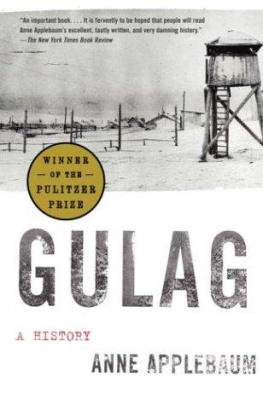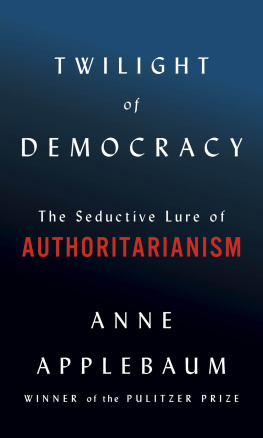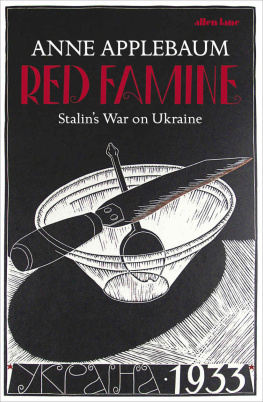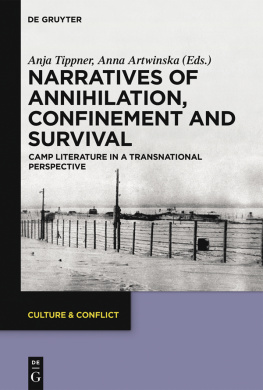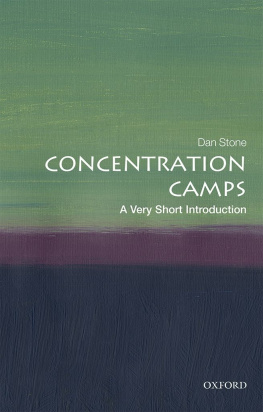ANNALS OF COMMUNISM
Each volume in the series Annals of Communism will publish selected and previously inaccessible documents from former Soviet state and party archives in a narrative that develops a particular topic in the history of Soviet and international communism. Separate English and Russian editions will be prepared. Russian and Western scholars work together to prepare the documents for each volume. Documents are chosen not for their support of any single interpretation but for their particular historical importance or their general value in deepening understanding and facilitating discussion. The volumes are designed to be useful to students, scholars, and interested general readers.
EXECUTIVE EDITOR OF THE ANNALS OF COMMUNISM SERIES
Jonathan Brent, Yale University Press
PROJECT MANAGER
Vadim A. Staklo
AMERICAN ADVISORY COMMITTEE
Ivo Banac, Yale University
Zbigniew Brzezinski, Center for Strategic and International Studies
William Chase, University of Pittsburgh
Friedrich I. Firsov, former head of the Comintern research group at RGASPI
Sheila Fitzpatrick, University of Chicago
Gregory Freeze, Brandeis University
John L. Gaddis, Yale University
J. Arch Getty, University of California, Los Angeles
Jonathan Haslam, Cambridge University
Robert L. Jackson, Yale University
Norman Naimark, Stanford University
Gen. William Odom (deceased), Hudson Institute and Yale University
Daniel Orlovsky, Southern Methodist University
Timothy Snyder, Yale University
Mark Steinberg, University of Illinois, Urbana-Champaign
Strobe Talbott, Brookings Institution
Mark Von Hagen, Arizona State University
Piotr Wandycz, Yale University
RUSSIAN ADVISORY COMMITTEE
K. M. Anderson, Moscow State University
N. N. Bolkhovitinov, Russian Academy of Sciences
A. O. Chubaryan, Russian Academy of Sciences
V. P. Danilov, Russian Academy of Sciences
A. A. Fursenko, secretary, Department of History, Russian Academy of Sciences (head of the Russian Editorial Committee)
V. P. Kozlov, director, Rosarkhiv
N. S. Lebedeva, Russian Academy of Sciences
S. V. Mironenko, director, State Archive of the Russian Federation (GARF)
O. V. Naumov, director, Russian State Archive of Social and Political History (RGASPI)
E. O. Pivovar, Moscow State University
V. V. Shelokhaev, president, Association ROSSPEN
Ye. A. Tyurina, director, Russian State Archive of the Economy (RGAE)
Gulag Voices
An Anthology
Edited by Anne Applebaum

Copyright 2011 by Anne Applebaum.
All rights reserved.
This book may not be reproduced, in whole or in part, including illustrations, in any form (beyond that copying permitted by Sections 107 and 108 of the U.S. Copyright Law and except by reviewers for the public press), without written permission from the publishers.
Yale University Press books may be purchased in quantity for educational, business, or promotional use. For information, please e-mail sales.press@yale.edu (U.S. office) or sales@yaleup.co.uk (U.K. office).
Designed by James J. Johnson and set in Sabon Roman type by Westchester Book Group.
Printed in the United States of America.
Library of Congress Cataloging-in-Publication Data
Gulag voices : an anthology / edited by Anne Applebaum.
p. cm. (Annals of communism)
ISBN 978-0-300-15320-0 (alk. paper)
1. Soviet UnionHistory19251953Biography. 2. Soviet UnionHistory 19531985Biography. 3. PrisonersSoviet UnionBiography. 4. Political prisonersSoviet UnionBiography. 5. Glavnoe upravlenie ispravitelno-trudovykh lagerei OGPUHistory. 6. PrisonersSoviet UnionSocial conditions. 7. Political prisonersSoviet UnionSocial conditions. 8. Forced laborSoviet Union History. 9. Concentration campsSoviet UnionHistory. I. Applebaum, Anne, 1964
DK268.A1G84 2011
365'.45092247dc22
2010033711
A catalogue record for this book is available from the British Library.
This paper meets the requirements of ANSI/NISO Z39.481992 (Permanence of Paper).
10 9 8 7 6 5 4 3 2 1
Contents
T he writers in this volume have one thing in common: all of them were arrested for political crimes in the Soviet Union, and all of them spent yearssometimes many yearsin the concentration camp system now known as the Gulag. There, however, their similarities end.
Certainly their backgrounds were very different. Some of them, such as the literary historian Dmitry Likhachev and the ethnographer Nina Gagen-Torn, held prominent positions among the Saint Petersburg intelligentsia. Others, among them Lev Razgon, were ambitious young members of the Bolshevik elite. Still others, including Hava Volovich and Elena Glinka, came from ordinary provincial families. Gustav Herling was a professional writer before his arrest, Isaak Filshtinsky a historian and scholar, Anatoly Zhigulin a poet. Kazimierz Zarod, by contrast, was a civil servant whose only book was his camp memoir.
Inside the camps, too, their experiences were very different. They held a variety of camp jobs, working in forests, mines, factories, and administrative positions. One had a baby; another was the victim of a mass rape. One was a norm-setter, a person who decided what labor norms other prisoners would have to fulfill. Another spent time in a sharashka, a special prison for scientists with a laboratory attached. They played different roles in the hierarchy and the culture of the camps, had different relationships with the professional criminals and the jailers and guards who watched over them. Some were shored up by their faith in God, others by close friendships. Still others kept sane by writing poetry or singing popular songs.
The wide variety of people and voices found in this book is not accidental, for the Gulag itself was an extraordinarily varied place. The word Gulag is an acronym: literally, it means Main Camp Administration. Over time, however, Gulag has also come to mean not just the camp administration but the entire Soviet slave-labor complex: labor camps, punishment camps, criminal and political camps, womens camps, childrens camps, transit camps, exile villages, Moscow prisons, rural prisons, railway cars. Each of the authors in this book survived at least one of these penal institutions. Some of them survived several.
Most of these essays were written by people who were imprisoned in the Gulag during Stalins reign, for those were the years when the camp population was the largest, the Gulags political role the most significant, and its contribution to the Soviet economy the greatest. Indeed, between 1929, when the labor camps first became a mass phenomenon, and 1953, the year of Stalins death, some 18 million people passed through them. In addition, a further 6 or 7 million were deported to exile villages. In total, the number of people who had some experience of imprisonment in Stalins Soviet Union could have run as high as 25 million, about 15 percent of the population.
But there had also been earlier camps, set up by Lenin and Feliks Dzerzhinsky in the 1920s as an ad hoc emergency measure to contain enemies of the people: Dmitry Likhachev survived one of these. And there were later camps, in existence from the time of Stalins death until the collapse of the Soviet Union in 1991. Some of these, such as the one in which Anatoly Marchenko was imprisoned, became notorious for treating political prisoners with even greater cruelty than had the camps of the earlier era.
The camps had an extraordinary geographical distribution as well. The Gulags most famous camps were in Siberia and the far North, where prisoners worked in mines and cut timber. But the Gulag also ran camps in central Moscow, where inmates built apartment blocks or designed airplanes; camps in Krasnoyarsk where prisoners ran nuclear power plants; and fishing camps on the Pacific coast. The Gulag photograph albums in the Russian State Archive contain pictures of prisoners with camels, prisoners in the desert, prisoners hoeing vegetables or shucking corn. From Aktyubinsk to Yakutsk, there is hardly a single major population center in the former Soviet Union that did not have its own local camp or camps, or a single industry that did not employ prisoners. Hence the central purpose of this anthology: to provide a sampling of the wide range of life in the Gulag, from transport ships to informers, from pregnancy to forestry.
Next page

